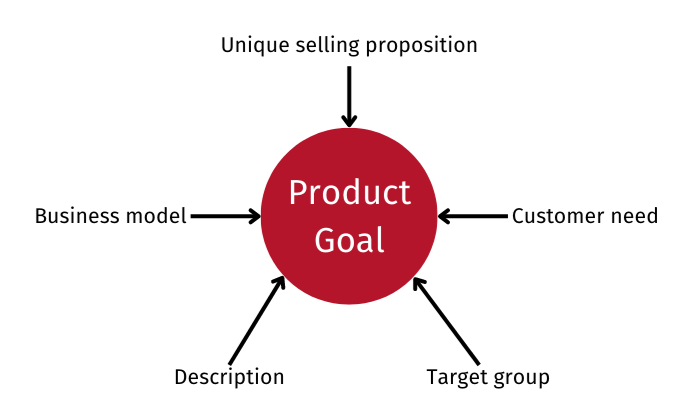Theory "Product Goal"
The development compass¶
With the Scrum Guide 2020, the Product Goal has replaced the Product Vision. In contrast to the Product Vision, the Product Goal, as the name suggests, describes a concrete goal that is pursued with the Scrum project and produced as a result of the Sprints. Unlike usual in Scrum projects, the Product Goal represents a longer-term goal, which - depending on the targeted product - lies two to six months in the future. As you already know from the previous chapter, the Product Goal is the commitment of the Scrum Team to the Product Backlog. It serves as a compass for the development of the current project. In other words, the Product Goal gives the developers a target to work towards while they are working on the Product Backlog.
Development of the Product Goal¶
The Product Goal should represent the future state of the project object and reflect what customers and users expect the product to be. Therefore, it makes sense to include exactly this target group in the development of the Product Goal. Feedback from users or (future) customers during the development of the Product Goal is important to ensure that the right product is developed. The Product Owner develops a common understanding of the goal for the stakeholders of the project and defines the framework conditions that serve the marketing of the product and its economic success. Although the Product Owner is solely responsible for the Product Goal, it should not be developed by him alone. Teamwork also plays an important role in defining the Product Goal. It has proven successful that the Product Owner begins with the development of the Product Goal and that the Scrum Team and other stakeholders then contribute their feedback. When developing the Product Goal, you should ask yourself the following questions:
- Why is the project being carried out?
- Which audience is to be addressed?
- What is the need or benefit of the client / consumer?
- What is the project about? What exactly is being offered?
- What are the unique selling points of the application or product compared to competitors?
- How is the business model structured?
- In which way is profit to be generated?

Work towards the product goal¶
Once the Product Goal is set, it is the responsibility of the Product Owner to communicate the Product Goal so that the Developers can work towards the Product Goal. Since the Product Goal represents the commitment to the Product Backlog, there should only be one Product Goal per Product Backlog and only when a Product Goal has been achieved a new Product Goal can be developed. Furthermore, the Product Goal should not be changed during the project. However, if it is necessary to adjust the Product Goal during the course of the project, for example because it becomes obsolete, then the Product Owner, in his function as the person responsible for the Product Backlog, should decide how to proceed. Is it enough to fine-tune the Product Goal? Do fundamental adjustments have to be made? Based on the answers, the Product Owner can involve the stakeholders, make a decision alone or consult the Developers.